A bitwise - Based indexing and heuristic-driven on - the - fly approach for Web service composition and verification
During the last decade, software engineering
community has witnessed the emerging of SOA architecture, where Web services play a crucial role. It prompts the
concept of Web Service Composition (WSC). Even though
interesting, this issue posed some remarkable challenges, one
of which is constraint handling. To be more precise, one
needs to ensure that the composite Web service fulfills, at
the same time, many constraints, including functional constraints, Quality of Service (QoS), and the execution order of
the component services, or temporal relations. Those constraints are of different natures, thus finding an efficient
verification on all kinds of constraints during the composition process is by no means a trivial task. Backed by a
solid foundation of temporal logic, model checking (MC) is
a suitable approach to handle this issue. However, MC-based
approach suffers from the infamous problem of state-space
explosion, making it limited when applied to real-life situations. The work in this paper addresses the problem by
proposing various approaches for handling the state-space
exploration, including (i) an introduction of an LTS-based
model known as LTS4WS, which can avoid generating full
schema of Web service composition and allow on-the-fly verification on the state space; (ii) heuristics strategies to find the
best potential composition, and (iii) a bitwise-based indexing mechanism for fast location of suitable Web services.
All of those approaches are unified in a single tool, known as
WSCOVER. As a result, a significant improvement of performance has been made, especially as compared with the
other existing works in the same field.
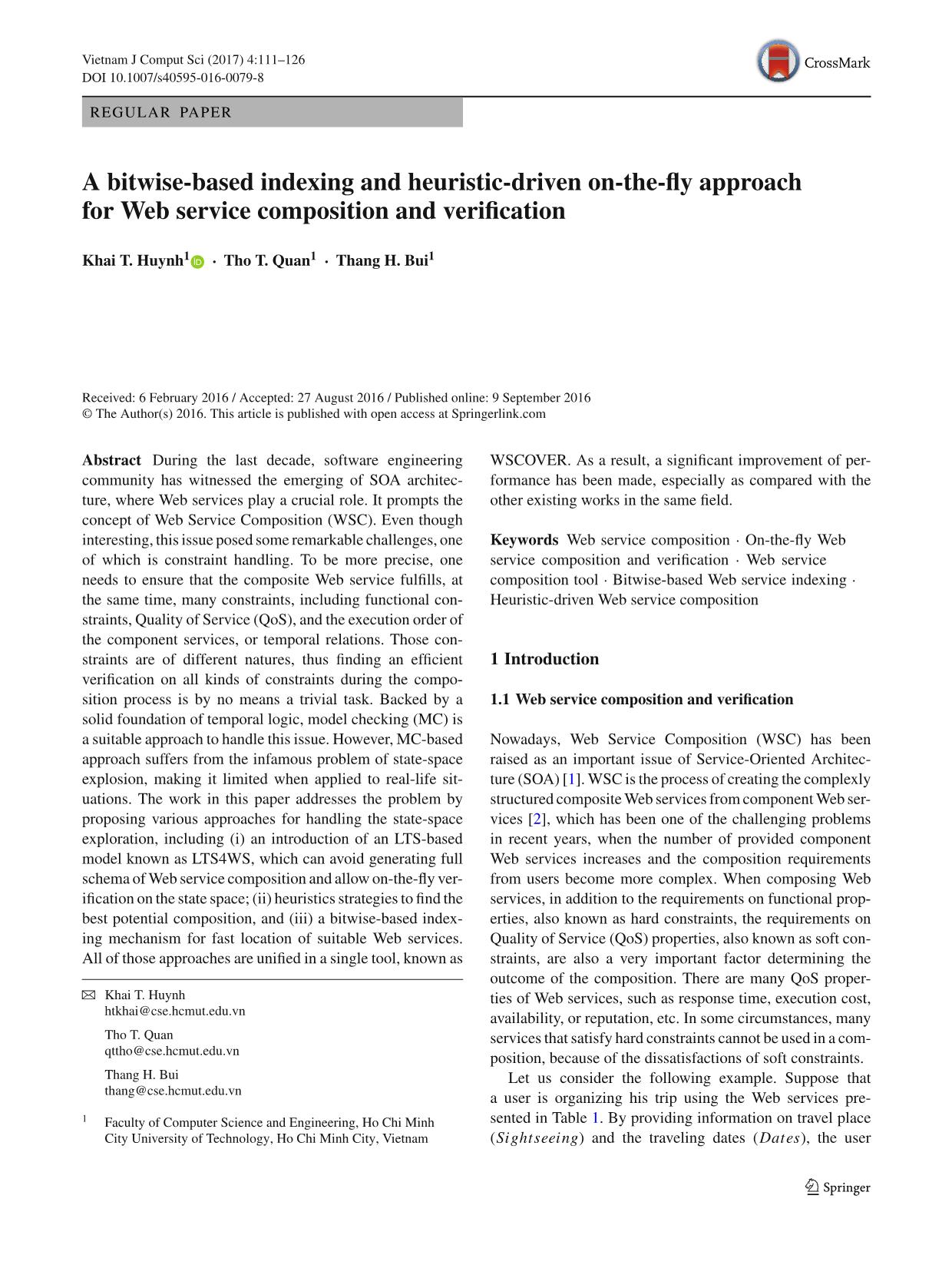
Trang 1

Trang 2
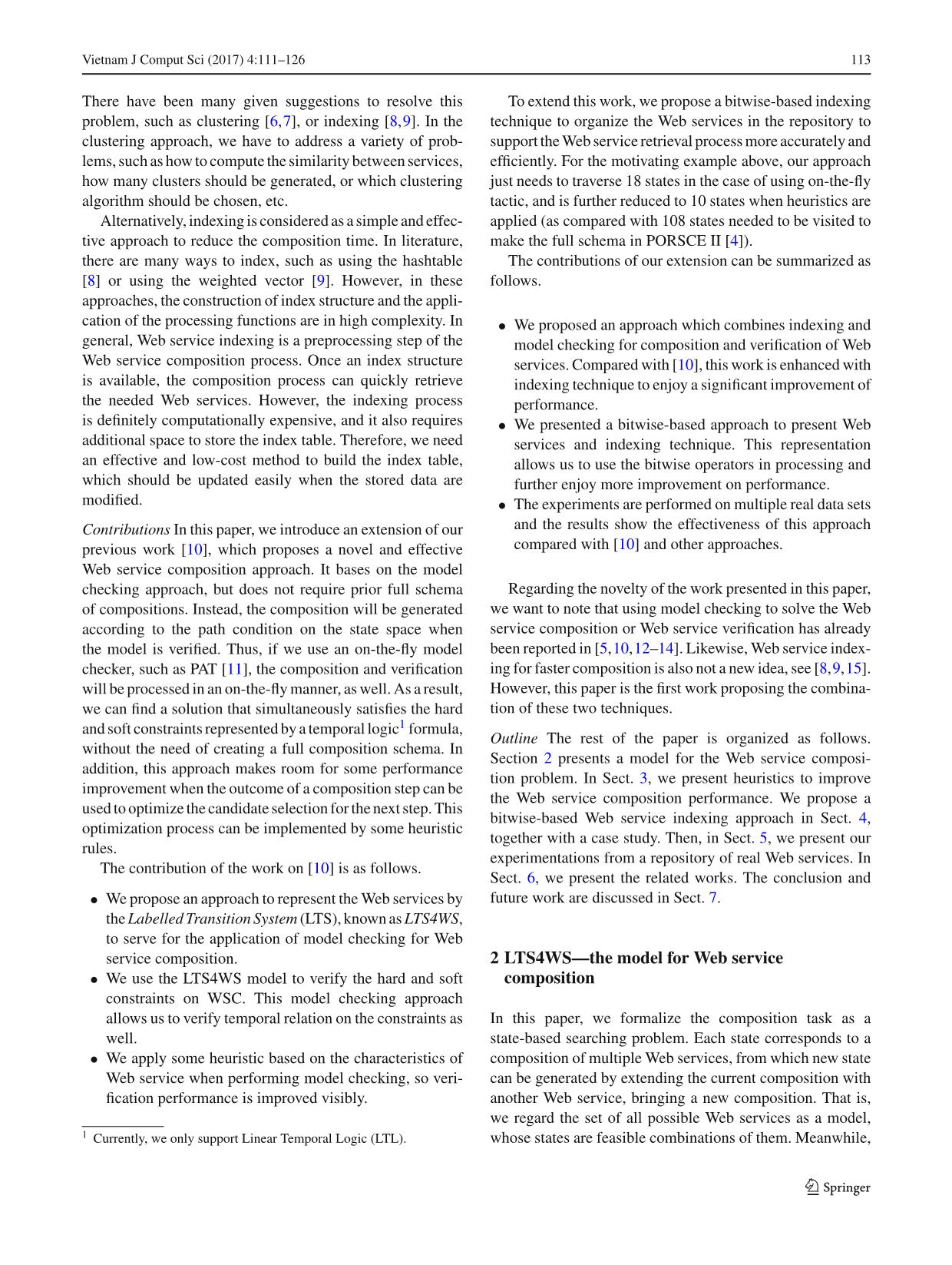
Trang 3
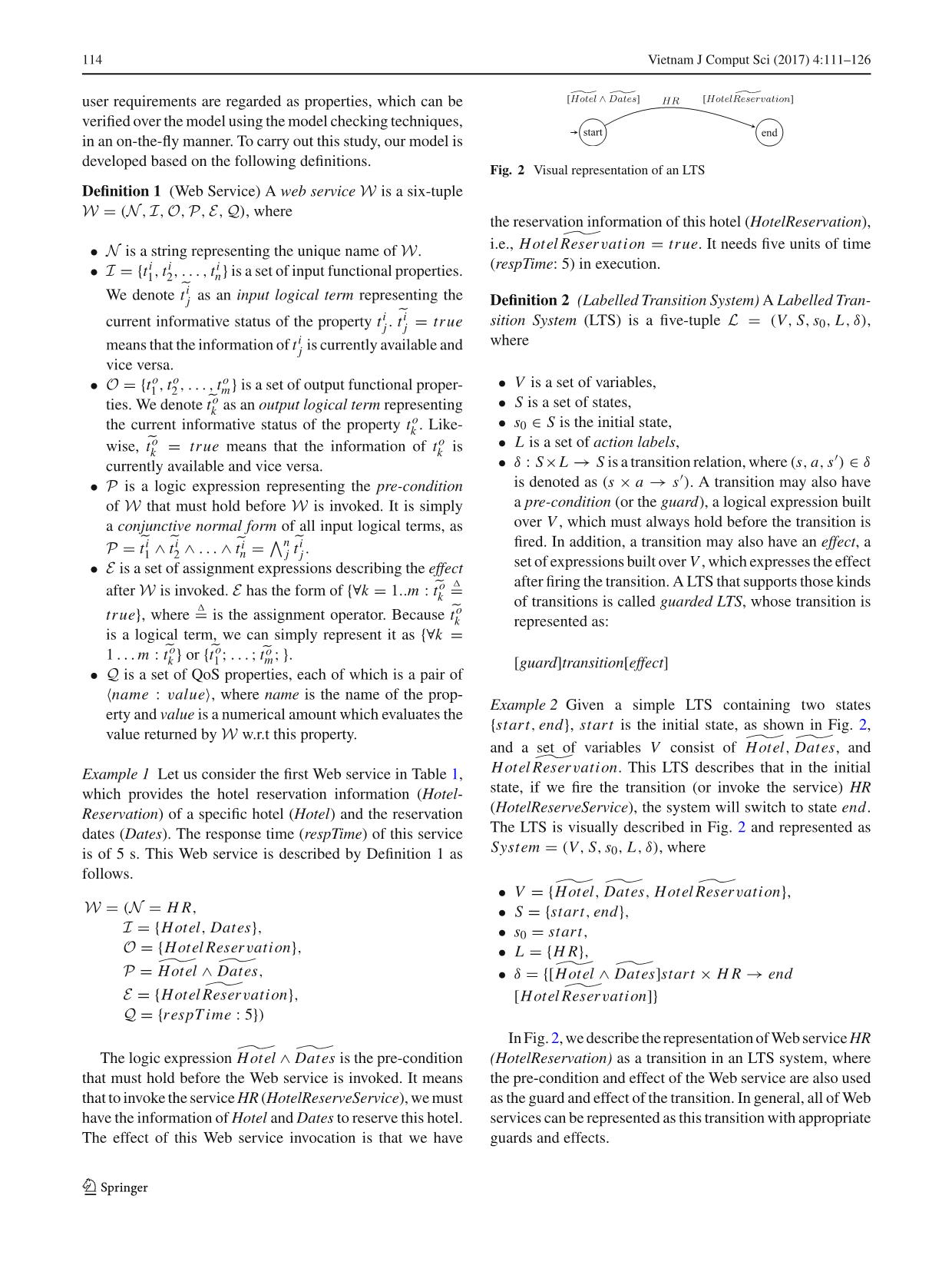
Trang 4
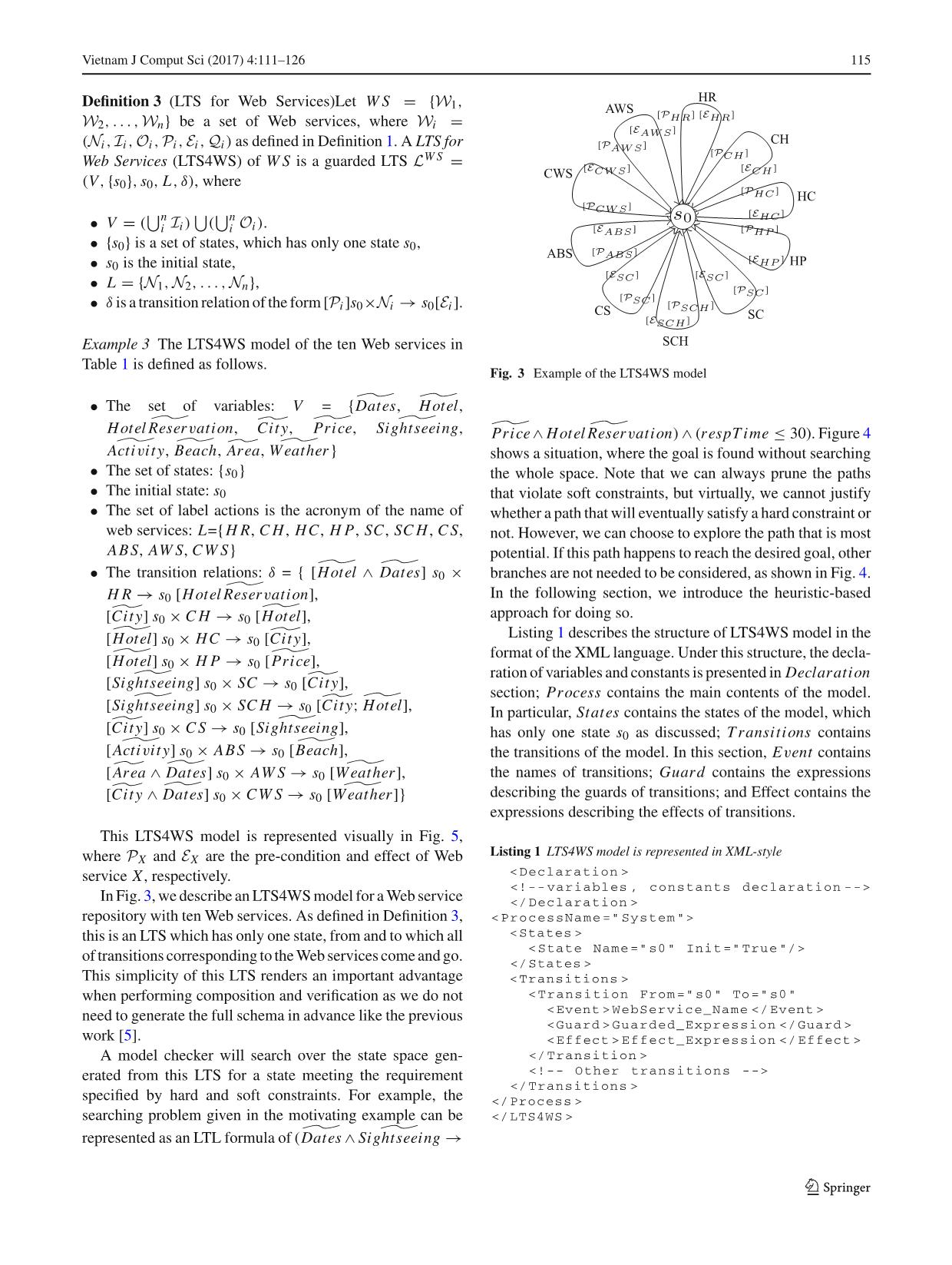
Trang 5
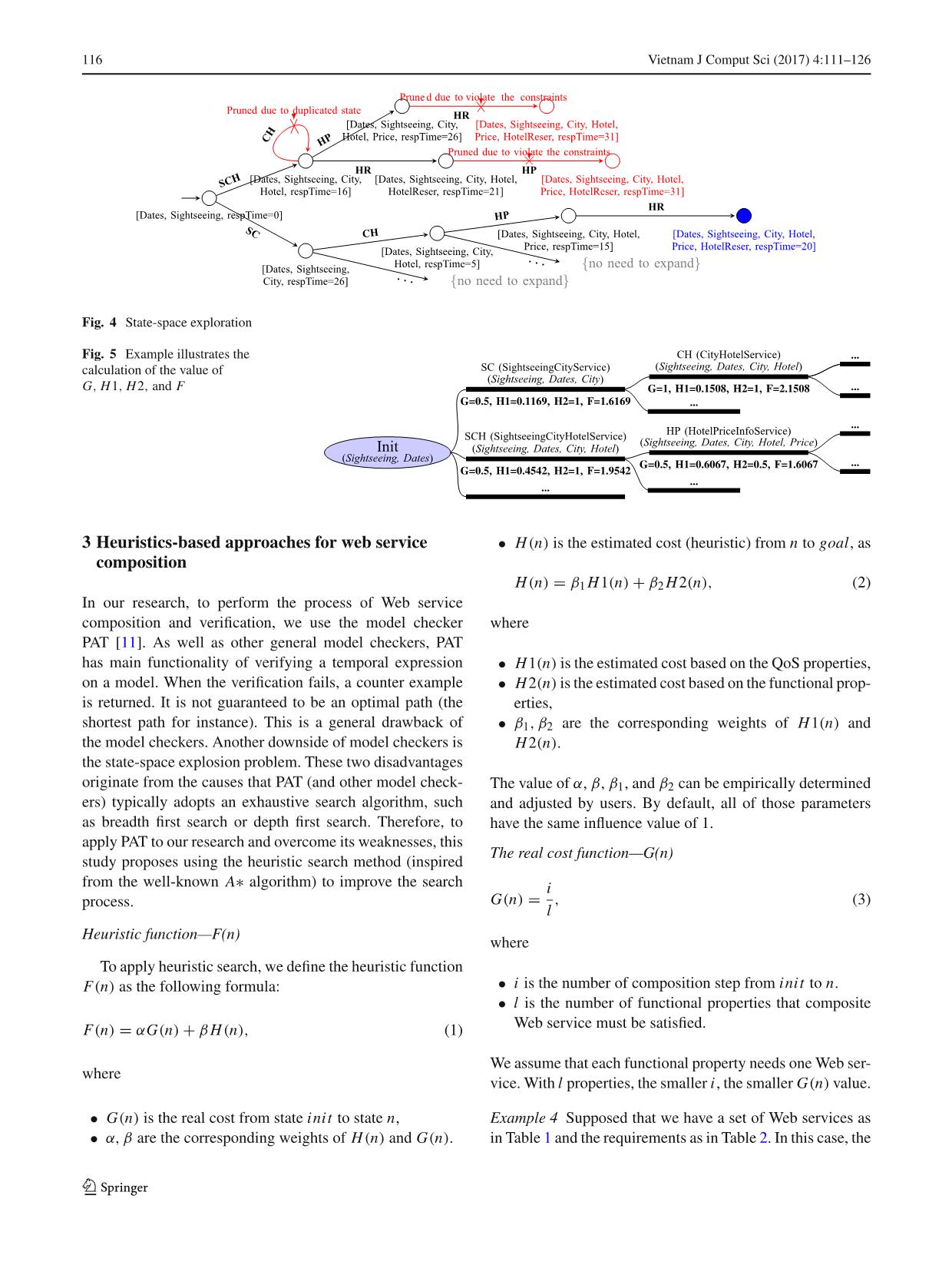
Trang 6
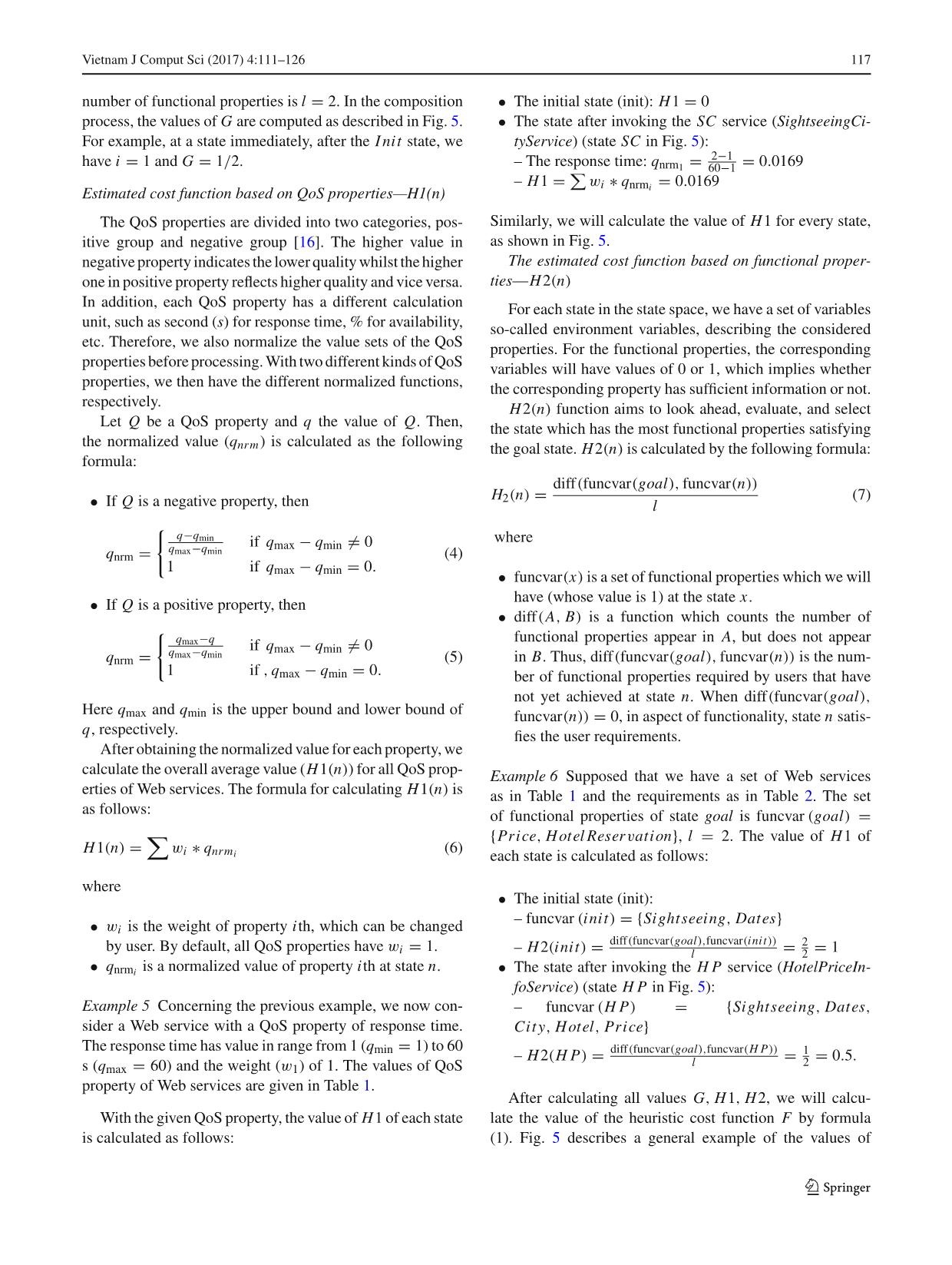
Trang 7
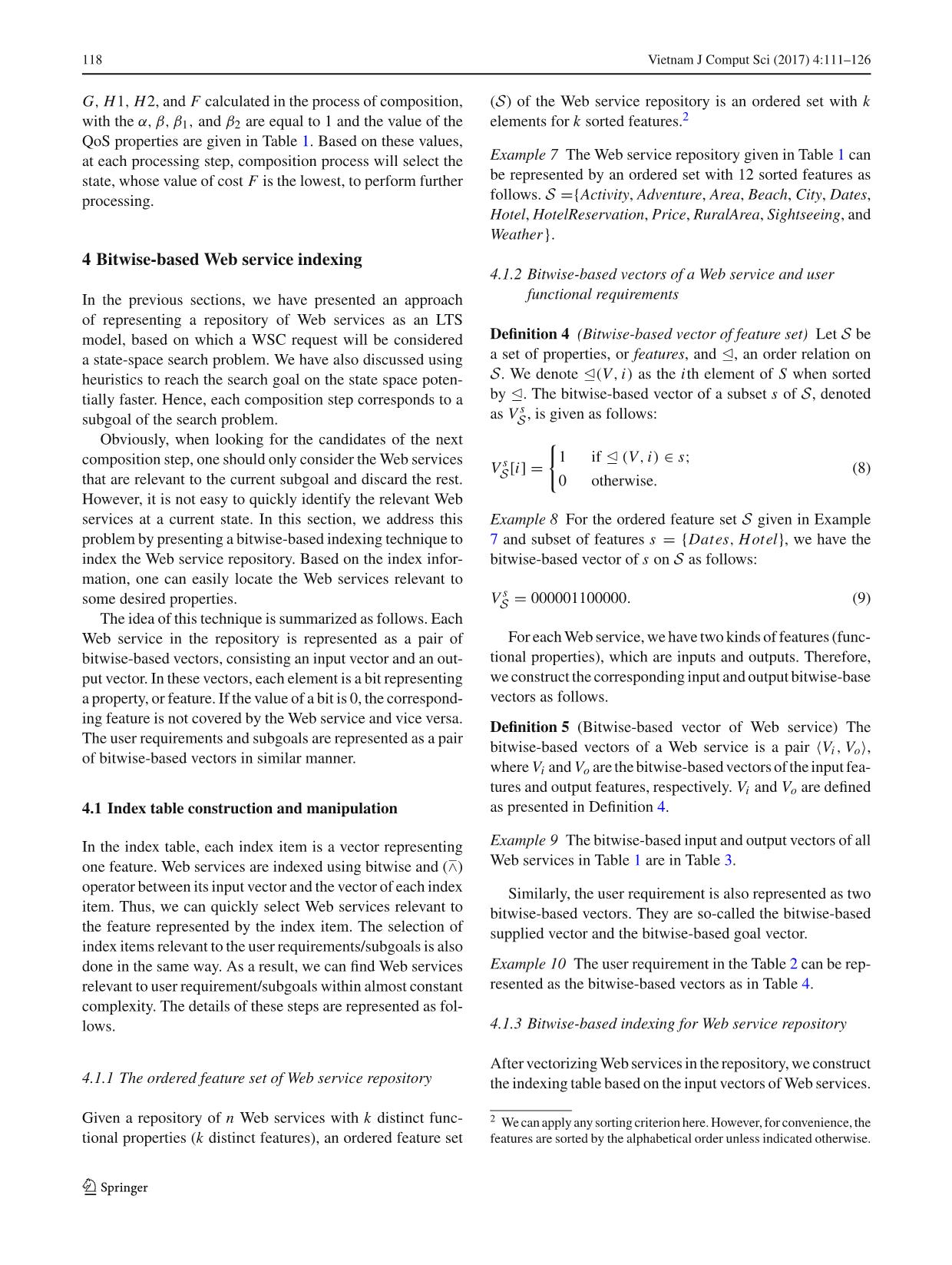
Trang 8

Trang 9
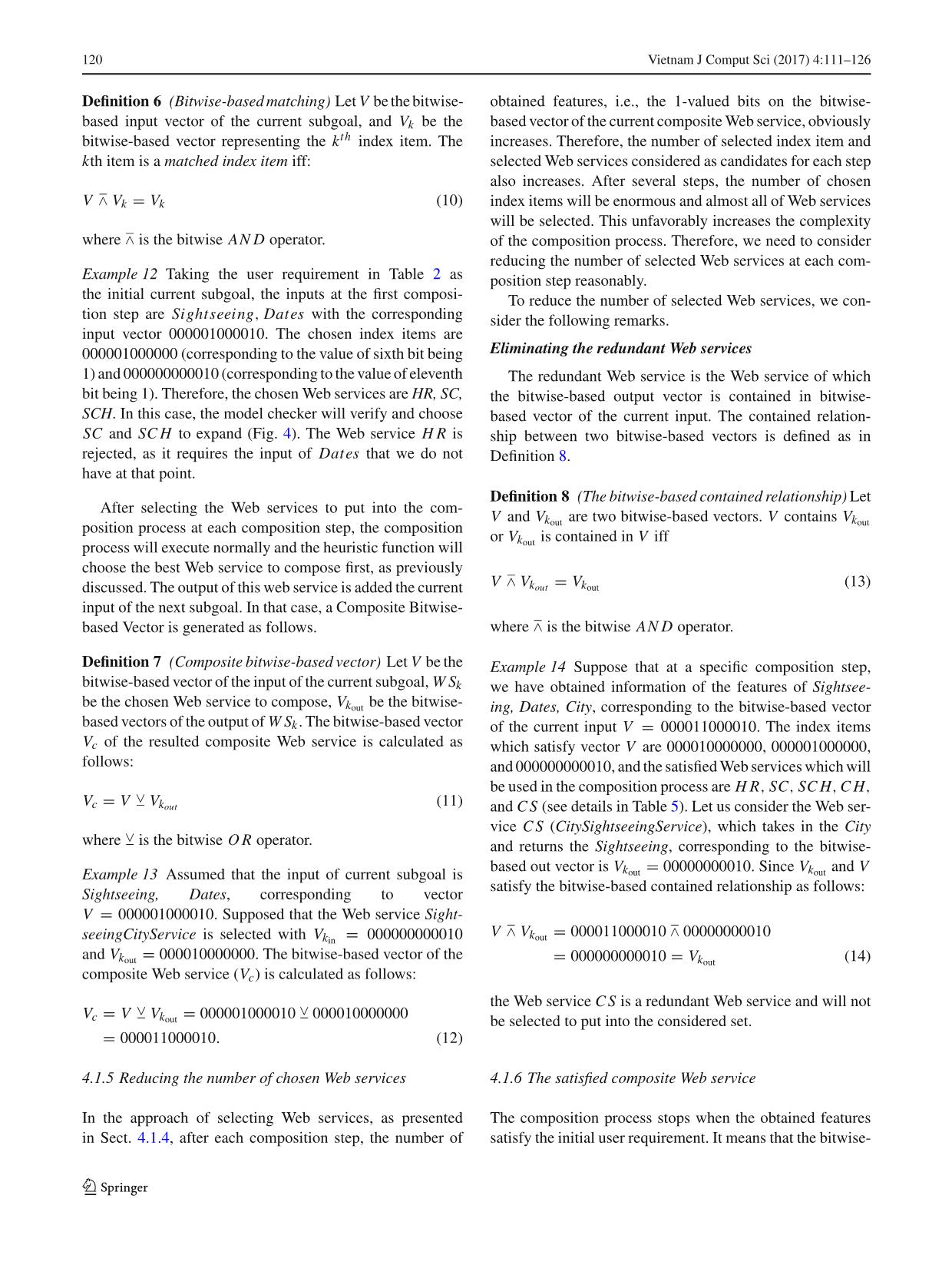
Trang 10
Tải về để xem bản đầy đủ
Tóm tắt nội dung tài liệu: A bitwise - Based indexing and heuristic-driven on - the - fly approach for Web service composition and verification
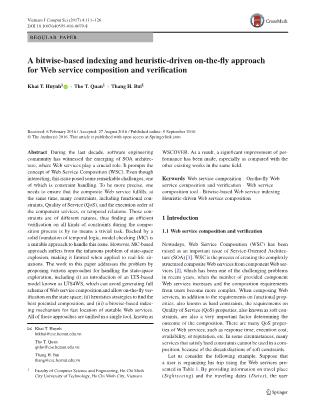
twise-based indexing with heuristic-driven on-the-fly composition and verification 316 35 0.155 EDS (100) Full schema verification 27,400 275 5.570 On-the-fly composition and verification 20,824 275 4.579 Heuristic-driven on-the-fly composition and verification 3021 151 3.294 Combined bitwise-based indexing with heuristic-driven on-the-fly composition and verification 316 35 0.155 ECS (200) Full schema verification 102,800 515 28.198 On-the-fly composition and verification 76,586 515 23.030 Heuristic-driven on-the-fly composition and verification 8324 287 18.273 Combined bitwise-based indexing with heuristic-driven on-the-fly composition and verification 316 35 0.155 Global (1000) Full schema verification Out-of-memory Out-of-memory Out-of-memory On-the-fly composition and verification Out-of-memory Out-of-memory Out-of-memory Heuristic-driven on-the-fly composition and verification 91,457 1429 597.228 Combined bitwise-based indexing with heuristic-driven on-the-fly composition and verification 316 35 0.155 Fig. 6 Visual representation of the experimental results 123 124 Vietnam J Comput Sci (2017) 4:111–126 As expected result, where the execution time mostly depends on the number of expanded states and visited states, all of our proposed methods are faster than the original one in existing work and our new proposed bitwise-based indexing approach achieves the fastest execution time (Fig. 6c). 6 Related works 6.1 Web service composition and verification Research community has a lot of work related to WSC prob- lem, which can be classified into three groups as follows. 6.1.1 Composition based on hard constraints WSC only involves the functional properties (hard con- straints) which is the classic problem of SOA, which are mostly based on the theory of planning of the artificial intel- ligence field (AI Planning), such as [4] and [19]. Some recent studies are based on abstract models, such as Petri net or Col- ored Petri Net [12–14] to compose and verify Web services. PORSCE II [4] is a framework implementing the WSC-based on the requirements on input and output of the services. Sim- ilarly, OWL-S-XPlan [19] also uses Web services expressed by OWL-S to transform the problem from WSC domain to planning domain and uses the planner named XPlan, con- structed by author. The studies [12–14] give the automatic WSC techniques based on Petri net (or Colored Petri net). 6.1.2 Composition based on hard and soft constraints WSC method which combines functional properties (hard constraints) and QoS properties (soft constraints) has been proposed in [16]. In [16], the authors have proposed apply- ing genetic algorithm (GA) to solve the problem with each possible composition encoded as a gene, to calculate value for specific kinds of QoS properties. However, this study only provides us a mechanism to choose the best (possible) composition from a set of composition ways (full compo- sition schema) rather than composes from the component Web services. Besides, the application of genetic algorithms has increased the complexity of the problem and thus very difficult to apply in practice. A different approach proposes the automated recovery when a WSC falls into the failure state (a Web service could not be accessed or unsatisfied the user requirement) [20]. With this approach, we have to have a full composition schema described in BPEL [21] language, which is trans- formed into a Labelled Transition System (LTS), monitored by a monitor automata. When an error arises (a state that cannot be reached, corresponding to a Web service cannot be accessed), the system will start calculating to choose the recovery plan using the genetic algorithm. The difference between [20] and [16] is that the size of gene in [20] is unfixed, which depends on the number of back-tracking steps from the error state. 6.1.3 Web service verification As discussed, most of current researches of Web service ver- ification only verify separately hard or soft constraints of the services. WS-Engineer [22] is typical work for the Web ser- vice verification based on the functional properties. A recent study carried out to verify combined functional and non- functional requirements of WSC is introduced as VeriWS [5], which takes in a full composition schema expressed in BPEL and uses the model checker to verify. 6.2 Web service indexing The number of web services is increasing rapidly. That makes the Web service composition approaches become more com- plex and face many difficulties. Therefore, the Web service indexing was suggested to support Web service accessing more efficient. This issue has received the attention of many researchers. Aiello et al. [8] index the Web service repository based on the services descriptions represented by the WSDL lan- guage. This approach uses the hash table to implement the index. The index structure consists of two tables, Partname Index and Service Index. Partname Index uses a hashtable to maintain the mapping from each partname into two lists of service names, namely, in list and out list. The Service Index utilizes a hashtable that maps a service name into detail information of the correspondent service. The information is request partnames, and response partnames. The study in [8] was implemented as the VitaLab system which performs the indexing of a large collection of WSDL service description following a semantic description of operations (given as a tree of “is-a” relations) and, given a request for a service, composes the available services to satisfy the request. Zhou et al. [15] proposed the way by which inverted indexing can be used for fast discovery of Web services. The indexing mechanisms can be either inverted indexing or latent semantic indexing. Here, inverted index can be used as a measure to check OWL-S description contain the given term. Each keyword is connected to a list of document ids, in which keyword occurs. Czyszczo and Aleksander in [9] proposed the solution for the problem of Web service retrieval by presenting a new approach to indexing of both SOAP and RESTful Web services. This approach uses index structure called para- metric index that allows users to retrieve ranked results in accordance with specific parameters. The parameters refer to service’s integral components and are covered in presented formal definition of a Web service. Second, the services are 123 Vietnam J Comput Sci (2017) 4:111–126 125 Table 8 Comparison on some of Web service composition and verification tools Tool Composition Verification Hard const. Soft const. Temporal Input OWL-S-XPlan X X OWL-S PORSCE II X X OWL-S WS-Engineer X X BPEL AgFlow X X Statechart VeriWS X X X X BPEL WSCOVER X X X X X OWL-S modelled in vector space that allows the evaluation of their mutual relevance and enables obtaining ranked search results. To reduce the index size and to decrease the search time, the approach in [9] uses the method of conceptual indexing which groups relevant service components into concepts. 6.3 Evaluation and comparison of our approach with other studies Table 8 presents the functional comparison our tool with others previously discussed. As observed, WSCOVER can perform both composition and verification at the same time and on-the-fly. Our tool composes and verifies a composite Web service on all kinds of constraints, hard and soft con- straint, and also the temporal relations between component Web services. To support model checking for composition and verifica- tion of Web services against a pre-defined goal in an effective manner, our work suggested representing a repository of Web services as a mathematical model, based on Labelled Transition System (LTS), known as LTS for Web Services (LTS4WS). Some other works, like the VeriWS tool [5], also propose using LTS models for enabling the formal verifica- tion of a WSC composition. However, our work distinguishes to this work as follows: • In [5], the LTS model is rebuilt when we consider new composition goal, even though the repository remains the same. In contrast, our LTS4WS model can be applied for several various goals without being rebuilt. • The work in [5] only verifies the composite Web service, it does not perform the composition phase. Meanwhile, our approach combines composition and verification at the same time. • We apply the heuristic search to model checking engine based on the characteristics of Web service, so the veri- fication performance is improved significantly. • We also apply the bitwise-based indexing technique to index the Web service repository. This approach helps us to retrieve the Web services further faster and more reasonably. To the best of our knowledge, it is the first work that combines formal verification with indexing techniques in the area of Web services processing. 7 Conclusion and future work The tool WSCOVER, developed in this research, has offered several useful functions that the other similar works do not support, including the capability of composing and verify- ing Web services, in an on-the-fly manner; and extending the model checker by applying the heuristics specifying the Web service nature. In addition, also through this paper, we have some contributions about the formal representation of Web service; the bitwise-based Web service indexing method to index the Web service repository using the bitwise opera- tors. This helps the building of the index table as well as the retrieval of Web services more efficient. As a result, WSCOVER can locate a composition solution faster and more optimally. However, in the future, this effort also needs to be compared with some other techniques, such as the clustering approaches to learn more about the pros and cons of our approach. In addition, in this work, we have not yet considered the semantic aspect of the features of Web services. We are going to develop a mechanism to calculate the similarity between two sets of features when they do not match completely. Acknowledgements This research is funded by Vietnam National Uni- versity HoChiMinh City under Grant Number C2015-20-10. Open Access This article is distributed under the terms of the Creative Commons Attribution 4.0 International License ( ons.org/licenses/by/4.0/), which permits unrestricted use, distribution, and reproduction in any medium, provided you give appropriate credit to the original author(s) and the source, provide a link to the Creative Commons license, and indicate if changes were made. References 1. Yin, R.: Study of composing web service based on soa, In: Proceedings of the 2nd International Conference on Green Com- munications and Networks 2012 (GCN 2012), vol. 2, pp. 209–214. Springer (2013) 123 126 Vietnam J Comput Sci (2017) 4:111–126 2. Rostami, N. H., Kheirkhah, E., Jalali, M.: Web services composi- tion methods and techniques: a review. Int J Comput Sci Eng Inf Technol 3(6), 15–29 (2013) 3. Fitting, M.: First-order logic. In: First-order logic and automated theorem proving, pp. 97–125. Springer, US (1990) 4. Hatzi, O., Vrakas, D., Bassiliades, N., Anagnostopoulos, D., Vla- havas, I.: The porsce ii framework: using ai planning for automated semantic web service composition. Knowl Eng Rev 28(02), 137– 156 (2013) 5. Chen, M., Tan, T. H., Sun, J., Liu, Y., Dong, J. S.: Veriws: a tool for verification of combined functional and non-functional require- ments of web service composition. In: Proceedings of the 36th International Conference on Software Engineering. ACM, pp. 564– 567 (2014) 6. Kumara, B.T., Paik, I., Chen, W., Ryu, K.H.: Web service clustering using a hybrid term-similarity measure with ontology learning. Int J Web Serv Res (IJWSR) 11(2), 24–45 (2014) 7. Du, Y.Y., Zhang, Y.J., Zhang, X.L.: A semantic approach of service clustering and web service discovery. Inf Technol J 12(5), 967–974 (2013) 8. Aiello, M., Platzer, C., Rosenberg, F., Tran, H., Vasko, M., Dustdar, S.: Web service indexing for efficient retrieval and composition. In: E-Commerce Technology, 2006. The 8th IEEE International Conference on and Enterprise Computing, E-Commerce, and E- Services, The 3rd IEEE International Conference on. IEEE, pp. 63–63 (2006) 9. Czyszczon´, A., Zgrzywa, A.: Indexing method for effective web service retrieval. Int J Intell Inf Database Syst 8(3), 189–208 (2014) 10. Huynh, K. T., Quan, T. T., Bui, T. H.: Fast and formalized: Heuristics-based on-the-fly web service composition and verifi- cation. In: Information and Computer Science (NICS), 2015 2nd National Foundation for Science and Technology Development Conference on. IEEE, pp. 174–179 (2015) 11. Liu, Y., Sun, J., Dong, J. S.: Developing model checkers using PAT. In: International symposium on automated technology for verifi- cation and Analysis, pp. 371–377. Springer, Berlin, Heidelberg (2010) 12. Fan, G., Yu, H., Chen, L., Liu, D.: Petri net based techniques for constructing reliable service composition. J Syst Softw 86(4), 1089–1106 (2013) 13. Maung, Y.W.M., Hein, A.A.: Colored petri-nets (cpn) based model for web services composition. IJCCER 2, 169–172 (2014) 14. Tian, B., Gu, Y.: Formal modeling and verification for web service composition. J Softw 8(11), 2733–2737 (2013) 15. Zhou, B., Huang, T., Liu, J., Shen, M.: Using inverted index- ing to semantic web service discovery search model. In: Wire- less Communications, Networking and Mobile Computing, 2009. WiCom’09. 5th International Conference on. IEEE, pp. 1–4 (2009) 16. AllamehAmiri, M., Derhami, V., Ghasemzadeh, M.: Qos-based web service composition based on genetic algorithm. J AI Data Min 1(2), 63–73 (2013) 17. Klusch, M.: Owls-tc: Owl-s service retrieval test collection, version 2.1. 18. Burstein, M., Hobbs, J., Lassila, O., Mcdermott, D., Mcilraith, S., Narayanan, S., Paolucci, M., Parsia, B., Payne, T., Sirin, E., et al.: Owl-s: Semantic markup for web services. W3C Member Submis- sion (2004) 19. Klusch, M., Gerber, A., Schmidt, M.: Semantic web service com- position planning with owls-xplan. In: Proceedings of the AAAI Fall Symposium on Semantic Web and Agents. AAAI Press, USA (2005) 20. Tan, T. H., Chen, M., André, É., Sun, J., Liu,Y., et al.: Automated runtime recovery for qos-based service composition. In: Proceed- ings of the 23rd international conference on World wide web. International World Wide Web Conferences Steering Committee, pp. 563–574 (2014) 21. Jordan, D., Evdemon, J., Alves et al.: Web services business process execution language version 2.0. OASIS Stand 11, 10 (2007) 22. Foster, H., Uchitel, S., Magee, J., Kramer, J.: Wsengineer: A model-based approach to engineering web service compositions and choreography. In: Test and analysis of web services, pp. 87– 103. Springer, Berlin, Heidelberg (2007) 123
File đính kèm:
 a_bitwise_based_indexing_and_heuristic_driven_on_the_fly_app.pdf
a_bitwise_based_indexing_and_heuristic_driven_on_the_fly_app.pdf

